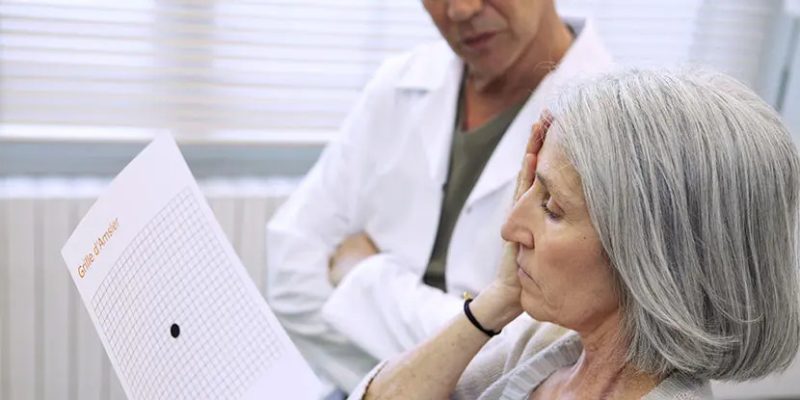What to Know After a Macular Degeneration Diagnosis
By Reena Mukamal for the American Academy of Ophthalmology Mar. 17, 2023
A macular degeneration diagnosis can seem overwhelming. Many people are frightened about losing vision and anxious about treatment. Learning about the disease can help you feel more in control and give you an advantage in protecting your sight.
Here’s some of the most common advice that macular degeneration specialist and Academy member G. Atma Vemulakanda, MD, gives newly diagnosed patients.
Will macular degeneration eventually cause blindness?
Macular degeneration can cause vision problems, but with proper treatment, most people can keep good vision for their entire lives.
Age related macular degeneration (AMD) causes problems with central vision, which can affect one’s ability to read, drive, or see someone’s face if the disease progresses to more advanced stages. Patients with intermediate disease may struggle with low contrast sensitivity and need task lighting. Challenges with depth perception or swiss cheese-like vision may become an issue for those with advanced disease. Vision loss can happen gradually and not be immediately noticeable. There are some tools your ophthalmologist can use to determine your risk of progression to advanced AMD, but every patient is unique and no one has a crystal ball to know exactly what might happen.
Overall, between 80 to 90% of people with AMD have the dry form of the disease, and few of these patients have visual limitations. As for the 10 to 20% of people with wet AMD, about 90% of these patients can stabilize or improve their vision with consistent treatment — even if they have already experienced vision loss, said Dr. Vemulakanda.
What is an Amsler Grid and why do I need to use it every day?
Catching and treating vision changes as soon as possible can help slow or stop further loss of sight. Your ophthalmologist will give you an Amsler grid to monitor your vision daily.
Using an Amsler grid takes less than a minute each day. Here are some tips to keep in mind:
- When you use it, you are checking for any change in how you see the lines of the grid.
- Use the grid in the same place every day, with the same lighting and at the same distance from your eyes.
- Test one eye at a time.
- If you think you see a change—no matter how subtle—call your ophthalmologist and get it checked out.
I’ve heard macular degeneration can be inherited. Should I have genetic testing?
It’s true that your risk of developing AMD is higher if some of your family members have been diagnosed with the condition. If AMD runs in your family, following the healthy lifestyle recommendations below can reduce your risk of eye disease. But once you have the condition, there is no benefit to genetic testing because the results won’t change your treatment plan. This may change in the future if gene therapies are developed for AMD.
Treating dry AMD: How can I slow vision loss from dry age-related macular degeneration?
There are a few ways that people with dry AMD can prevent further vision loss:
Lifestyle changes
All patients diagnosed with dry AMD should stop smoking, exercise regularly and eat a diet rich in colorful vegetables and fruits as well as foods containing omega 3 fatty acids such as fish and nuts. It’s also important to maintain a healthy blood pressure.
Patients with intermediate-stage dry AMD can also benefit from AREDS 2 vitamin supplements. These vitamins were named after the clinical trials (known as the Age-Related Eye Disease Studies) that showed how well they slow the progression of AMD. AREDS 2 vitamins are only recommended for patients who have already developed macular degeneration. Before you begin to use any vitamins on a regular basis, ask your primary care physician for approval.
Treating wet AMD: Eye injections can protect sight in wet age-related macular degeneration
It can take several weeks before patients notice a response from injections of anti-VEGF drugs, so it’s important to stick to the treatment plan. Injections are needed on a monthly basis to start, but may be extended to longer intervals depending on the individual. Stopping or pausing injections can lead to recurring vision loss that may be permanent.
Eye injections aren’t as painful as they sound
You may be apprehensive about the idea of a needle going into your eye, but injections aren’t as painful as patients’ fear of them. The eye is numbed first and patients don’t usually see the needle. The injection itself only take a few seconds. Dr. Vemulakanda often tells his patients that after the shot the eye can feel sore, similar to arm soreness after a flu shot. Patients may also feel a slight burning sensation, similar to the feeling of getting soap in the eye.
Wet AMD treatments may raise the risk of cataracts or glaucoma
All intraocular procedures carry some risk of worsening cataracts or elevating eye pressure (also known as intraocular pressure, or IOP). The amount of risk depends on a number of factors such as the patient’s age, family history, medical conditions and whether they smoke cigarettes. Your retina specialist will carefully monitor your eye pressure and other aspects of eye health.
New treatments for AMD are on the horizon
A number of promising new medications for both forms of AMD have been in clinical trials, and researchers are currently analyzing the data for safety and efficacy.
Low vision resources can maximize your vision
If you have lost a significant amount of central vision, your ophthalmologist should refer you to a low vision specialist, an expert who can help connect you with tools and strategies to make the most of your remaining vision. This specialist can recommend magnifiers, electronic devices and even smart phone apps that can aid you in performing many daily tasks. In addition, they can help you organize and set up your home in the safest and most efficient way.

